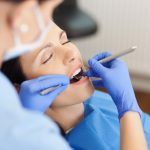Dental crowns and bridges are two restorative techniques that repair damaged or missing teeth. They restore tooth function and appearance. The use of dental crowns and bridges also avoids shifting teeth that can happen after a tooth is lost. By maintaining or restoring the patient’s bite and smile, the effects of the tooth damage or loss are reversed.
The procedures for making and fitting dental crowns and bridges are very similar. Both require two trips to the dentist’s office. During the first trip, the tooth or teeth that will be crowned will be reduced, that is, prepared to support the crown structure. This involves removing one to two millimeters of tooth structure. Of course, if the tooth damage is the reason for the crown, that is the part that is removed. The reduction process leaves a thimble shape that will receive the crown or crown ends of the bridge.
With both dental crowns and bridges, recovery is quick, with teeth feeling back to normal within a day or two. If the teeth remain sensitive for a period longer than this, or there is pain that cannot be controlled by over-the-counter medication, you should return to your dentist. Further adjustments may need to be made with the crown or bridge placement.
Restoration of both dental crowns and bridges are durable and aesthetic restorations. They were developed to restore badly damaged or missing teeth. Regardless of how your teeth were damaged, restorations of dental crowns and bridges will make your smile beautiful again.
Appearance is an important aspect in the development of self esteem, and thus that it is always recommended to restore teeth as promptly as possible. Even a single missing tooth can cause your other teeth to drift and become crooked. Additionally, missing teeth or teeth that are too broken down can affect your ability to eat and speak. This is where your dentist and crowns and bridges come in.






